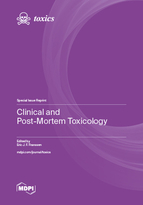Clinical and Post-Mortem Toxicology
A special issue of Toxics (ISSN 2305-6304). This special issue belongs to the section "Drugs Toxicity".
Deadline for manuscript submissions: closed (20 November 2023) | Viewed by 21427
Special Issue Editor
Special Issue Information
Dear Colleagues,
It is my pleasure to invite you to submit papers in the field of clinical, post-mortem, and forensic toxicology. Papers (also review papers) addressing the methodology of comprehensive toxicology screening (e.g., LC-MS libraries), as well as the presentation of clinical cases and case series, are welcome. Further, we will welcome papers dealing with post-mortem and forensic toxicology.
This Special Issue will address the challenges in detecting exposure and intoxications of various (recreative) drugs and novel active psychoactive drugs that are widely available on the internet. How do we detect these agents and their metabolites in body fluids? What are the potentials and limitations of comprehensive and targeted toxicology screening in both clinical and forensic settings? What are the options and challenges for drugs testing at the point of care and crime? This Special Issue also addresses novel options for the clinical management of intoxicated patients, including the prevention of (re)absorption, and the extracorporally enhanced elimination of drugs and specific antidotes. In cases of post-mortem toxicology, how do we interpret drug levels in blood and how do we deal with post-mortem redistribution and degradation?
Dr. Eric J. F. Franssen
Guest Editor
Manuscript Submission Information
Manuscripts should be submitted online at www.mdpi.com by registering and logging in to this website. Once you are registered, click here to go to the submission form. Manuscripts can be submitted until the deadline. All submissions that pass pre-check are peer-reviewed. Accepted papers will be published continuously in the journal (as soon as accepted) and will be listed together on the special issue website. Research articles, review articles as well as short communications are invited. For planned papers, a title and short abstract (about 100 words) can be sent to the Editorial Office for announcement on this website.
Submitted manuscripts should not have been published previously, nor be under consideration for publication elsewhere (except conference proceedings papers). All manuscripts are thoroughly refereed through a single-blind peer-review process. A guide for authors and other relevant information for submission of manuscripts is available on the Instructions for Authors page. Toxics is an international peer-reviewed open access monthly journal published by MDPI.
Please visit the Instructions for Authors page before submitting a manuscript. The Article Processing Charge (APC) for publication in this open access journal is 2600 CHF (Swiss Francs). Submitted papers should be well formatted and use good English. Authors may use MDPI's English editing service prior to publication or during author revisions.
Keywords
- clinical toxicology
- comprehensive toxicology screening
- post-mortem toxicology
- forensic toxicology
- drugs testing and analysis
- point-of-care drug testing
- LC-MS toxicology screening







